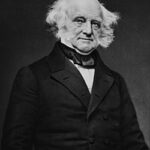Martin Van Buren inherited Andrew Jackson’s Indian Removal Act when he assumed presidency in 1837. The Cherokee Trail of Tears represented his most controversial decision. Van Buren chose political expediency over humanitarian concerns.
The Cherokee Trail of Tears Decision
Van Buren faced immediate pressure to complete Cherokee removal from Georgia. The Supreme Court had ruled in Cherokee Nation v. Georgia (1831) that tribes were “domestic dependent nations.” Jackson ignored this ruling. Van Buren continued the same policy. He appointed General Winfield Scott to oversee the forced relocation. ⚠️ Scott commanded 7,000 federal troops to remove 16,000 Cherokee people from their ancestral lands.
The Brutal Forced March
The Cherokee called this journey “Nunna daul Tsuny” – the trail where they cried. Removal began in May 1838 during Georgia’s hottest months. Families received no time to gather belongings or prepare for the journey. 📊 The 1,200-mile trek to Oklahoma Territory took four months. Poor planning led to inadequate food, medical supplies, and shelter.
Van Buren’s Political Calculations
Van Buren prioritized Democratic Party unity over Cherokee rights. Southern Democrats demanded immediate removal completion. The president feared losing political support in key states. 💰 Georgia’s gold rush intensified pressure to clear Cherokee lands. Van Buren chose party loyalty over moral leadership during this critical moment.
Impact:
The Cherokee Trail of Tears created devastating consequences that lasted generations. Van Buren’s decision strengthened federal authority while destroying Native American communities. The policy established dangerous precedents for future government actions.
Immediate Human Catastrophe
🔥 Approximately 4,000 Cherokee people died during the forced march to Oklahoma. Disease, starvation, and exposure claimed victims daily. Children and elderly suffered disproportionately high mortality rates. Families were permanently separated during the chaos. Survivors arrived traumatized and destitute in unfamiliar territory. Traditional Cherokee society faced complete disruption.
Political and Social Consequences
📉 Van Buren’s approval ratings plummeted among Northern abolitionists and humanitarian groups. The decision strengthened opposition to Democratic expansionist policies. Whig Party leaders used the Cherokee Trail of Tears against Van Buren in 1840 elections. Northern newspapers condemned the administration’s cruelty. Religious groups organized protests in major cities.
Long-term Historical Legacy
🌍 International observers criticized American treatment of indigenous peoples. The policy damaged America’s reputation as a beacon of freedom and justice. Van Buren’s decision influenced subsequent Indian Wars throughout the 19th century. Modern scholars classify the removal as ethnic cleansing. The Cherokee Trail of Tears remains a defining example of government-sanctioned human rights violations in American history.
